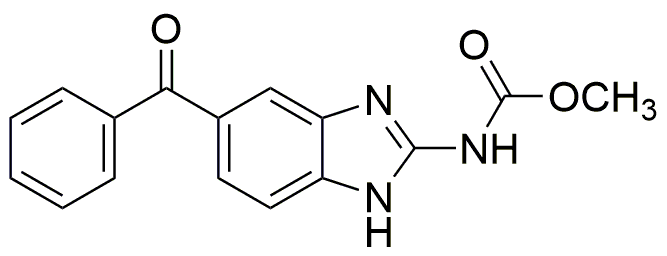Mebendazole is widely utilized in research focused on:
- Antiparasitic Treatments: Primarily used to treat parasitic infections such as roundworm and hookworm, making it essential in both human and veterinary medicine.
- Pharmaceutical Formulations: Incorporated into various drug formulations due to its effectiveness and low toxicity, enhancing patient compliance and treatment outcomes.
- Research on Drug Resistance: A valuable compound in studies investigating drug resistance in parasites, helping researchers develop more effective treatments.
- Veterinary Medicine: Extensively used in the livestock industry to control parasitic infections, thereby improving animal health and productivity.
- Potential Anticancer Properties: Emerging research suggests it may have applications in cancer treatment, providing a new avenue for therapeutic exploration.
General Information
Properties
Safety and Regulations
Applications
Mebendazole is widely utilized in research focused on:
- Antiparasitic Treatments: Primarily used to treat parasitic infections such as roundworm and hookworm, making it essential in both human and veterinary medicine.
- Pharmaceutical Formulations: Incorporated into various drug formulations due to its effectiveness and low toxicity, enhancing patient compliance and treatment outcomes.
- Research on Drug Resistance: A valuable compound in studies investigating drug resistance in parasites, helping researchers develop more effective treatments.
- Veterinary Medicine: Extensively used in the livestock industry to control parasitic infections, thereby improving animal health and productivity.
- Potential Anticancer Properties: Emerging research suggests it may have applications in cancer treatment, providing a new avenue for therapeutic exploration.
Documents
Safety Data Sheets (SDS)
The SDS provides comprehensive safety information on handling, storage, and disposal of the product.
Product Specification (PS)
The PS provides a comprehensive breakdown of the product’s properties, including chemical composition, physical state, purity, and storage requirements. It also details acceptable quality ranges and the product's intended applications.
Certificates of Analysis (COA)
Search for Certificates of Analysis (COA) by entering the products Lot Number. Lot and Batch Numbers can be found on a product’s label following the words ‘Lot’ or ‘Batch’.
Numéro de catalogue
Numéro de lot/série
Certificates Of Origin (COO)
This COO confirms the country where the product was manufactured, and also details the materials and components used in it and whether it is derived from natural, synthetic, or other specific sources. This certificate may be required for customs, trade, and regulatory compliance.
Numéro de catalogue
Numéro de lot/série
Safety Data Sheets (SDS)
The SDS provides comprehensive safety information on handling, storage, and disposal of the product.
DownloadProduct Specification (PS)
The PS provides a comprehensive breakdown of the product’s properties, including chemical composition, physical state, purity, and storage requirements. It also details acceptable quality ranges and the product's intended applications.
DownloadCertificates of Analysis (COA)
Search for Certificates of Analysis (COA) by entering the products Lot Number. Lot and Batch Numbers can be found on a product’s label following the words ‘Lot’ or ‘Batch’.
Numéro de catalogue
Numéro de lot/série
Certificates Of Origin (COO)
This COO confirms the country where the product was manufactured, and also details the materials and components used in it and whether it is derived from natural, synthetic, or other specific sources. This certificate may be required for customs, trade, and regulatory compliance.

